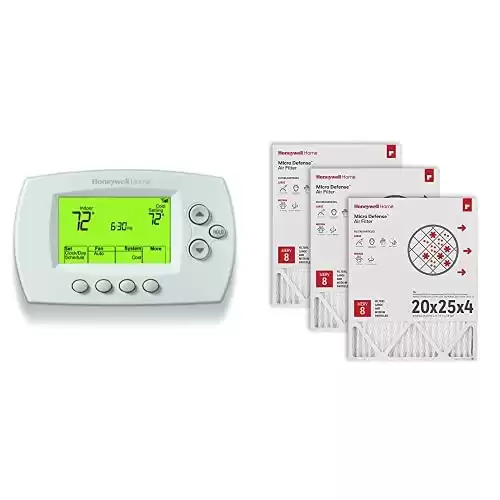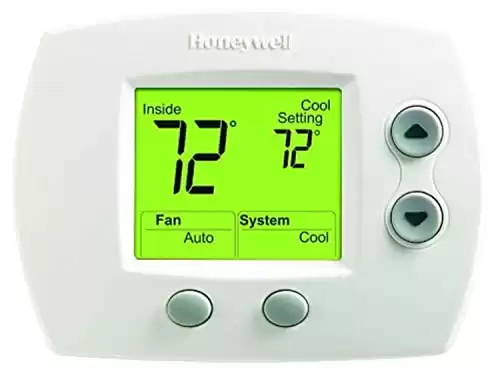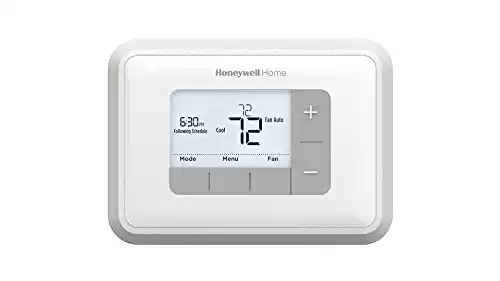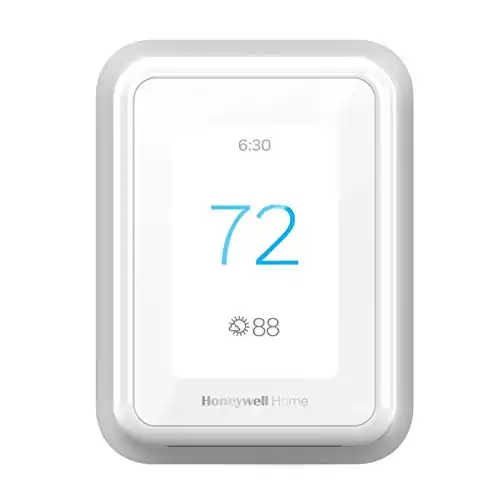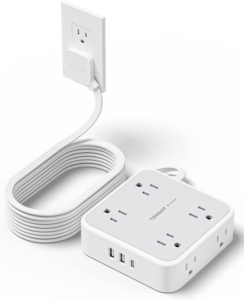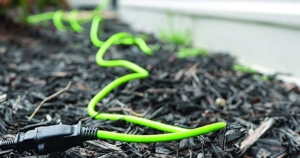Honeywell Thermostats Traditional vs. Smart Models
Thermostats enable us to maintain a comfortable environment while also helping us save energy. Honeywell, a renowned thermostat manufacturer, offers a range of options to suit different needs. In this blog, we will explore the differences between traditional and smart Honeywell thermostats and help you determine the best fit for your home.
Traditional Thermostats: Pros and Cons
Pros of Smart Thermostats:
1. Energy Efficiency: Smart thermostats can learn your temperature preferences and adjust settings accordingly, optimizing energy usage and potentially saving you money on utility bills.
2. Remote Access and Control: With smart thermostats, you can control your home’s temperature from anywhere using a smartphone app or a web portal. This allows you to adjust settings even when you’re not at home, ensuring comfort and convenience.
3. Learning Capabilities: Many smart thermostats have built-in algorithms that learn your heating and cooling patterns over time. They can automatically adjust the temperature based on your behavior, schedule, and weather conditions, providing personalized comfort without manual intervention.
4. Integration with Home Automation: Smart thermostats often integrate with other smart home devices, such as voice assistants (e.g., Amazon Alexa, Google Assistant) and smart speakers. This enables seamless voice control and integration into broader home automation systems.
5. Energy Usage Monitoring: Smart thermostats provide detailed insights into your energy consumption patterns. You can track and analyze your usage over time, identify energy-saving opportunities, and make informed decisions to reduce your environmental footprint.
Cons of Smart Thermostats:
1. Cost: Smart thermostats can be more expensive upfront compared to traditional thermostats. However, the potential energy savings over time may offset the initial investment.
2. Complexity: Smart thermostats often have more features and settings than traditional thermostats. This can make them more complex to set up and configure, especially for users who are less tech-savvy.
3. Internet Dependence: Smart thermostats rely on an internet connection to function fully. If your internet goes down or there are connectivity issues, you may lose remote control and some advanced features until the connection is restored.
4. Privacy and Data Security: Smart thermostats collect data about your temperature preferences, occupancy patterns, and energy usage. Some users may have concerns about data privacy and how that information is stored, used, and protected by the thermostat manufacturer.
Pros of Traditional Thermostats:
1. Simplicity: Traditional thermostats are generally simpler in terms of functionality and operation. They typically have basic temperature control settings without additional features or learning capabilities, which can be more straightforward for some users.
2. Reliability: Traditional thermostats have a long history of use and are generally reliable devices. They often have fewer components and are less susceptible to software bugs or internet connectivity issues.
3. Lower Upfront Cost: Traditional thermostats are generally less expensive upfront compared to smart thermostats, making them a more budget-friendly option for those seeking basic temperature control.
Cons of Traditional Thermostats:
1. Lack of Automation: Traditional thermostats require manual adjustments to maintain desired temperature settings. They don’t have the ability to learn and optimize settings based on your behavior or external factors like weather conditions.
2. Limited Accessibility: With traditional thermostats, you need to physically interact with the device to adjust temperature settings. This can be inconvenient if you want to change settings remotely or if you have limited mobility.
3. Potential Energy Waste: Without the learning capabilities and automated features of smart thermostats, traditional thermostats may result in unnecessary energy consumption if users forget to adjust settings when they are away or asleep.
4. Lack of Integration: Traditional thermostats often lack integration with other smart home devices, limiting their compatibility with home automation systems or voice control options.
Overall, the choice between a smart thermostat and a traditional thermostat depends on your specific needs, budget, and preferences for convenience, energy efficiency, and automation.
Honeywell Traditional Thermostat Models
Honeywell is a well-known brand in the thermostat industry, and they offer a range of traditional thermostat models. Here are some popular traditional thermostat models from Honeywell:
1. Honeywell CT87K: This is a classic round manual thermostat that has been used for decades. It features a simple dial for temperature adjustment and a mercury switch for accurate temperature control.
2. Honeywell CT50K1002/E1: This is a basic manual thermostat with a rectangular design. It offers straightforward temperature control with a dial and has a compact and easy-to-use interface.
3. Honeywell RTH111B1016/A: This is a non-programmable thermostat with a digital display. It allows you to set and adjust the desired temperature manually, but it does not have advanced scheduling or learning capabilities.
4. Honeywell RTH221B1021/A: Another non-programmable digital thermostat, this model provides basic temperature control and has a simple interface with a clear display.
5. Honeywell RLV4305A1000/E1: This is a line voltage thermostat specifically designed for electric baseboard heating systems. It offers manual temperature control with a dial and includes a backlit display for easy reading.
6. Honeywell TH5110D1006/U: This is a basic programmable thermostat that allows you to set a schedule for different temperature settings throughout the day. It has a digital display and simple programming options.
These are just a few examples of traditional Honeywell thermostat models. Honeywell also offers a wide range of other models with various features, including programmable options, touchscreen displays, and Wi-Fi connectivity. It’s important to research and choose a model that suits your specific heating and cooling needs.
Honeywell Smart Thermostat Models
Honeywell offers several smart thermostat models that provide advanced features and connectivity options. Here are some popular smart thermostat models from Honeywell:
1. Honeywell Home T9 Smart Thermostat: This model features remote access and control through the Honeywell Home app. It has a color touchscreen display, geofencing capabilities, and supports multi-room zoning for enhanced comfort and energy efficiency.
2. Honeywell Home T10 Pro Smart Thermostat: The T10 Pro offers similar features to the T9 model, including remote control, geofencing, and multi-room zoning. It is designed for professional installation and integration with smart home systems.
3. Honeywell Home T6 Pro Smart Thermostat: The T6 Pro is a programmable smart thermostat that allows you to create a schedule and control it remotely through the Honeywell Home app. It supports geofencing and works with voice assistants like Amazon Alexa and Google Assistant.
4. Honeywell Home T5+ Smart Thermostat: This model offers a cost-effective smart thermostat option. It features Wi-Fi connectivity for remote control, programmable scheduling, and compatibility with voice assistants.
5. Honeywell Home RTH9585WF Wi-Fi Smart Color Thermostat: The RTH9585WF is a full-color touchscreen smart thermostat. It offers Wi-Fi connectivity, customizable display options, and compatibility with voice assistants. It also supports geofencing and features intelligent alerts.
6. Honeywell Home Lyric T6 Pro Wi-Fi Thermostat: The Lyric T6 Pro is a programmable smart thermostat with Wi-Fi connectivity. It allows you to create customized schedules, control temperature remotely, and integrates with smart home systems and voice assistants.
These are just a few examples of Honeywell’s smart thermostat models. It’s worth noting that Honeywell may release new models or update existing ones, so it’s a good idea to visit their official website or consult with a professional to explore the latest offerings and features available.
Factors to Consider When Choosing
There are several factors to consider to determine whether a traditional or smart Honeywell thermostat is the right choice for your home. Budget and cost considerations are significant, as smart thermostats generally have a higher upfront cost. Your lifestyle and convenience preferences will also affect your decision, as smart thermostats provide remote access and automation. Additionally, compatibility with your home’s existing systems and energy efficiency goals should be considered.
Summary: Honeywell Thermostats: Traditional vs. Smart Models
In conclusion, traditional and smart Honeywell thermostats have advantages and limitations. Standard thermostats are cost-effective, simple to use, and reliable but lack advanced features. Smart thermostats offer enhanced energy efficiency, remote access, and automation but are more expensive. When choosing the right Honeywell thermostat for your home, evaluate your personal needs and preferences. Consider budget, lifestyle, compatibility, and energy efficiency goals. By doing so, you can select the ideal Honeywell thermostat that aligns with your specific circumstances and provides optimal temperature control in your home.



